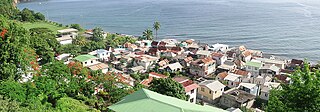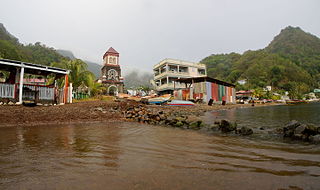
Roseau is the capital and largest city of Dominica, with a population of 16,571 as of 2023. It is a small and compact urban settlement, in the Saint George parish and surrounded by the Caribbean Sea, the Roseau River and Morne Bruce. Built on the site of the ancient Island Carib village of Sairi, it is the oldest and most important urban settlement on the island of Dominica.
Salisbury is a town on the west coast of the small Caribbean island nation of Dominica. It is located at 15°26′9″N61°26′13″W and is a part of the country's St. Joseph administrative division. Its population is 2,129.

Kelvin Edward Felix, OBE, SLMH, DAH is the Roman Catholic Archbishop emeritus of Castries, St Lucia. He was born in Roseau, Dominica, on 15 February 1933. He became a cardinal at the papal consistory held on 22 February 2014.

The Metropolitan Archdiocese of Castries is an archdiocese of the Latin Church of the Catholic Church in the Caribbean. The archdiocese consists of the entirety of the former British dependency of Saint Lucia and is a metropolitan see, the suffragans of the Castries Province being the Dioceses of Roseau, Saint George's in Grenada, St. John's-Basseterre and Kingstown. The archdiocese is a member of the Antilles Episcopal Conference.

The Roman Catholic Diocese of Saint John's–Basseterre is a diocese of the Latin Church of the Roman Catholic Church, covering five English-speaking jurisdictions in the Caribbean. The bishopric is a suffragan of the Metropolitan Archdiocese of Castries, and a member of the Antilles Episcopal Conference, but remains dependent on the missionary Dicastery for Evangelization.

Portsmouth is the second largest town in Dominica, with 3,630 inhabitants. It is located on the shore of a natural Harbor, Prince Rupert Bay, in Saint John Parish on the north-west coast of Dominica. The area was called Ouyouhao by the Kalinago and Grand Anse by the French. The Indian River is Portsmouth’s southern border and Cabrits National Park is located on a peninsula to the north of town.

Wesley is a village in Saint Andrew Parish in north-eastern Dominica. It situated between the old estates of Eden and Londonderry and 1 1/2 miles southeast of Woodford Hill. Like many other villages along the east coast Wesley developed after Emancipation on hilly land along the boundary between the two estates as labourers sought to establish independent holdings for themselves away from the plantations where they had formerly lived and worked.

Colihaut is a coastal village in northern Dominica within Saint Peter Parish midway between the towns of Roseau and Portsmouth. It has a population of 773 people.

Vieille Case, sometimes spelled as Vielle-Case, is a village on the north coast of Dominica. The Commonwealth of Dominica in the West Indies was first inhabited by the Kalinago people who were referred to as Caribs by the Europeans. Itassi is the Kalinago name for the area in Dominica which is now known as Vieille Case.

Dublanc is a village in Saint Peter parish on the west coast of Dominica between the town of Portsmouth and the village of Bioche. It sits on a low hillside at an elevation of 27. As of 2001 it had a population of 423.

The Roman Catholic Diocese of Roseau is a diocese of the Latin Church of the Roman Catholic Church in the Caribbean. The diocese encompasses the entirety of the country of Dominica. The diocese is a suffragan of the Archdiocese of Castries, and a member of the Antilles Episcopal Conference.

Dominica officially the Commonwealth of Dominica, is an island country in the Caribbean. The capital, Roseau, is located on the western side of the island. It is geographically situated as part of the Windward Islands chain in the Lesser Antilles archipelago in the Caribbean Sea. Dominica's closest neighbours are two constituent territories of the European Union, the overseas departments of France, Guadeloupe to the northwest and Martinique to the south-southeast. Dominica comprises a land area of 750 km2 (290 sq mi), and the highest point is Morne Diablotins, at 1,447 m (4,747 ft) in elevation. Its population was 71,293 at the 2011 census.
The Antilles Episcopal Conference (AEC) is a Roman Catholic episcopal conference. Its members are bishops and archbishops from current and former British, Dutch, and French colonies and dependencies in the Caribbean, Central America, and northern South America. The conference's membership includes five archdioceses, fourteen dioceses, and two missions sui iuris. These particular Churches minister to Catholics in thirteen independent nations, six British Overseas Territories, three departments of France, three countries of the Kingdom of the Netherlands and 3 municipalities of the Netherlands proper.

The Cathedral of Our Lady of Fair Haven of Roseau, originally known in French as Église de Notre-Dame du Bon Port du Mouillage de Roseau, is a Roman Catholic cathedral in Roseau, the capital city of Dominica in the Caribbean. The church is the see of the Diocese of Dominica, suffragan diocese of the Archdiocese of Castries, Saint Lucia.
Edward Joseph Gilbert is a 20th- and 21st-century American-born bishop of the Catholic Church in the Antilles. He served as bishop of the Diocese of Roseau in Dominica, from 1994-2001. He was the Archbishop of Port of Spain, Trinidad and Tobago between 2001-2011.
Belles is a small village in the Caribbean island nation of Dominica. It is located at 15°27′12.7″N61°19′11.4″W and is a part of the country's St. Joseph administrative division. Its population is 500. Belles is a historical site for a few reasons. It is a major part of the highway system to the northern part of the island. The roads were blocked many years ago by Rastafarians who were not happy with the government. Many of them escaped to Jaco Flats and used it for refuge. This is a site that was used by the Maroons hundreds of years ago. As of 2016, the Esprit and Benjamin families own and control a majority of the private land.
Michael Naughten was an Irish clergyman and bishop for the Roman Catholic Diocese of Roseau in Dominica. He went to Dominica along with Fr John Molly and Fr. Patrick Smith, all from the College of All Hallows in Dublin, Ireland, where they were trained for the foreign missions. He was appointed bishop in 1879, and consecrated bishop in Mullingar by Bishop Nulty, in 1880 the 4th Bishop of Roseau, successor to Bishop René-Marie-Charles Poirier. Bishop Naughton invited The Nuns of the Faithful Virgin, from Kennsington, England, to operate schools in the Diocese.












